Похожие презентации:
This genocide is now known as the Holocaust
1.
2.
3. Between 1933 and 1945, the German government led by Adolf Hitler and the Nazi Party carried out the systematic persecution and
murder of Europe’s Jews.This genocide is now known
as the Holocaust.
4. The Nazi regime also persecuted and killed millions of other people it considered politically, racially, or socially unfit.
5. The Allies’ victory ended World War II, but Nazi Germany and its collaborators had left millions dead and countless lives
shattered.6. In March 1933, Adolf Hitler addressed the first session of the German Parliament (Reichstag) following his appointment as
TAKEOVER OF POWER, 1933In March 1933, Adolf Hitler addressed the first session
of the German Parliament (Reichstag) following his
appointment as chancellor.
7. After this photograph was taken, all political parties in the Reichstag—with the exception of the Socialists and
TAKEOVER OF POWER, 1933After this photograph was taken, all political parties in
the Reichstag—with the exception of the Socialists and
Communists—passed the “Enabling Act” giving Hitler
the power to rule by emergency decree.
8. A storm trooper (SA) guards newly arrested members of the German Communist Party in a basement jail of the SA barracks in
THE TERROR BEGINSA storm trooper (SA) guards newly arrested members
of the German Communist Party in a basement jail
of the SA barracks in Berlin.
9. Communists, Socialists, and other political opponents of the Nazis were among the first to be rounded up and imprisoned by the
THE TERROR BEGINSCommunists, Socialists, and other political opponents
of the Nazis were among the first to be rounded up and
imprisoned by the regime.
10. A woman reads a boycott sign posted on the window of a Jewish-owned department store. The Nazis initiated a boycott of Jewish
FROM CITIZENS TO OUTCASTSA woman reads a boycott sign
posted on the window of a Jewishowned department store. The Nazis
initiated a boycott of Jewish shops
and businesses on April 1, 1933,
across Germany.
11. Many Germans continued to enter the Jewish stores despite the boy-cott, and it was called off after 24 hours. In the subsequent
FROM CITIZENS TO OUTCASTSMany Germans continued to enter
the Jewish stores despite the boycott, and it was called off after 24
hours. In the subsequent weeks
and months more discriminatory
measures against Jews followed
and remained in effect.
12. An instructional chart distinguishes individuals with pure “German blood” (left column), “Mixed blood” (second and third
NAZI RACE LAWSAn instructional chart distinguishes individuals with
pure “German blood” (left column), “Mixed blood”
(second and third columns), and Jews (right two
columns), as defined in the Nuremberg Laws.
13. Among other things, the laws issued in September 1935 restricted future German citizenship to those of “German or kindred
NAZI RACE LAWSAmong other things, the laws issued in September
1935 restricted future German citizenship to those
of “German or kindred blood,” and excluded those
deemed to be “racially” Jewish or Roma (Gypsy).
14. The laws prohibited marriage and sexual relation-ships between Jews and non-Jews.
NAZI RACE LAWSThe laws prohibited marriage and sexual relationships between Jews and non-Jews.
15. Members of the Hitler Youth receive instruction in racial hygiene at a Hitler Youth training facility. The Nazis divided the
THE “SCIENCE” OF RACEMembers of the Hitler Youth receive instruction in
racial hygiene at a Hitler Youth training facility. The
Nazis divided the world’s population into superior and
inferior “races.”
16. According to their ideology, the “Aryan race,” to which the German people allegedly belonged, stood at the top of this racial
THE “SCIENCE” OF RACEAccording to their ideology, the “Aryan race,” to which
the German people allegedly belonged, stood at the top
of this racial hierarchy.
17. The Nazi ideal was the Nordic type, displaying blond hair, blue eyes, and tall stature.
THE “SCIENCE” OF RACEThe Nazi ideal was the Nordic type, displaying blond
hair, blue eyes, and tall stature.
18. Residents of Rostock, Germany, view a burning synagogue the morning after Kristallnacht (“Night of Broken Glass”). On the night
“NIGHT OF BROKEN GLASS”Residents of Rostock, Germany,
view a burning synagogue the
morning after Kristallnacht
(“Night of Broken Glass”). On
the night of November 9–10,
1938, the Nazi regime unleashed
orchestrated anti-Jewish violence
across greater Germany.
19. Within 48 hours, synagogues were vandalized and burned, 7,500 Jewish businesses were damaged or destroyed, 96 Jews were killed,
“NIGHT OF BROKEN GLASS”Within 48 hours, synagogues
were vandalized and burned,
7,500 Jewish businesses were
damaged or destroyed, 96 Jews
were killed, and nearly 30,000
Jewish men were arrested and
sent to concentration camps.
20. Within the concentration camp system, colored, tri-angular badges identified various prisoner categories, as seen in this image
“ENEMIES OF THE STATE”Within the concentration camp system, colored, triangular badges identified various prisoner categories,
as seen in this image of a roll call at the Buchenwald
concentration camp.
21. Although Jews were their primary targets, the Nazis also persecuted Roma (Gypsies), persons with mental and physical
“ENEMIES OF THE STATE”Although Jews were their primary targets, the Nazis
also persecuted Roma (Gypsies), persons with mental
and physical disabilities, and Poles for racial, ethnic,
or national reasons.
22. Millions more, including homosexuals, Jehovah’s Wit-nesses, Soviet prisoners of war, and political dissidents, also suffered
“ENEMIES OF THE STATE”Millions more, including homosexuals, Jehovah’s Witnesses, Soviet prisoners of war, and political dissidents,
also suffered oppression and death.
23. Jews in Vienna wait in line at a police station to obtain exit visas. Following the incorporation of Austria by Nazi Germany in
SEARCH FOR REFUGEJews in Vienna wait in line at a
police station to obtain exit visas.
Following the incorporation of
Austria by Nazi Germany in
March 1938, and the unleashing
of a wave of humiliation, terror,
and confiscation, many Austrian
Jews attempted to leave the
country.
24. Before being allowed to leave, however, Jews were required to get an exit visa, plus pay large sums of money in taxes and
SEARCH FOR REFUGEBefore being allowed to leave,
however, Jews were required to
get an exit visa, plus pay large
sums of money in taxes and
additional fees.
25. Government policies in the 1930s made it difficult for Jews seeking refuge to settle in the United States.
AMERICAN RESPONSESGovernment policies in the 1930s made it difficult
for Jews seeking refuge to settle in the United States.
26. In May 1939 the passenger ship St. Louis—seen here before departing Hamburg—sailed from Germany to Cuba carrying 937
AMERICAN RESPONSESIn May 1939 the passenger ship St. Louis—seen here
before departing Hamburg—sailed from Germany to
Cuba carrying 937 passengers, most of them Jews.
27. Unknown to the passengers, the Cuban government had revoked their landing certificates.
AMERICAN RESPONSESUnknown to the passengers, the Cuban government
had revoked their landing certificates.
28. After the U.S. government denied permission for the passengers to enter the United States, the St. Louis returned to Europe.
AMERICAN RESPONSESAfter the U.S. government denied permission for the
passengers to enter the United States, the St. Louis
returned to Europe. Some 250 of the refugees would
later be killed in the Holocaust.
29. Sections of Warsaw lay in ruins following the invasion and conquest of Poland by the German military begun in September 1939
THE WAR BEGINSSections of Warsaw lay in ruins following the invasion
and conquest of Poland by the German military begun
in September 1939 that propelled Europe into World
War II.
30. For most of the next two years German forces occupied or controlled much of continental Europe.
THE WAR BEGINSFor most of the next two years German forces
occupied or controlled much of continental Europe.
31. By the end of 1942, however, the Allies were on the offensive and ultimately drove back the German forces.
THE WAR BEGINSBy the end of 1942, however, the Allies were on the
offensive and ultimately drove back the German forces.
32. The war in Europe ended with the unconditional surrender of Germany in May 1945.
THE WAR BEGINSThe war in Europe ended with the unconditional
surrender of Germany in May 1945.
33. Jews in the Warsaw ghetto wait in line for food at a soup kitchen.
LIFE IN THE GHETTOJews in the Warsaw ghetto wait in line for food at a
soup kitchen.
34. Ghettos were city districts, often enclosed, in which the Germans concentrated the municipal and some-times regional Jewish
LIFE IN THE GHETTOGhettos were city districts, often enclosed, in which
the Germans concentrated the municipal and sometimes regional Jewish population to control and
segregate it from the non-Jewish population.
35. In November 1940, German authorities sealed the Warsaw ghetto, severely restricting supplies for the more than 300,000 Jews
LIFE IN THE GHETTOIn November 1940, German authorities sealed the
Warsaw ghetto, severely restricting supplies for the
more than 300,000 Jews living there.
36. Survival was a daily challenge as inhabitants struggled for the bare necessities of food, sanitation, shelter, and clothing.
LIFE IN THE GHETTOSurvival was a daily challenge as inhabitants struggled
for the bare necessities of food, sanitation, shelter, and
clothing.
37. About a quarter of all Jews who perished in the Holocaust were shot by SS mobile killing squads and police battalions following
MOBILE KILLING SQUADSAbout a quarter of all Jews
who perished in the Holocaust
were shot by SS mobile killing
squads and police battalions
following the German invasion
of the Soviet Union in June
1941.
38. These units carried out the mass murder of Jews, Roma, and Communist government officials. This man was mur-dered in the
MOBILE KILLING SQUADSThese units carried out the
mass murder of Jews, Roma,
and Communist government
officials. This man was murdered in the presence of members of the German Army, the
German Labor Service, and
the Hitler Youth.
39. Between 1942 and 1944, trains carrying Jews from German-controlled Europe rolled into one of the six killing centers located
DEPORTATIONSBetween 1942 and 1944, trains carrying Jews
from German-controlled Europe rolled into one of
the six killing centers located along rail lines in
occupied Poland.
40. Commonly between 80 and 100 people were crammed into railcars of this type. Deportation trains usually carried 1,000 to 2,000
DEPORTATIONSCommonly between 80 and 100 people were
crammed into railcars of this type. Deportation
trains usually carried 1,000 to 2,000 people.
41. Many died during the extreme conditions of the journey, and most survivors were murdered upon arrival at the killing centers.
DEPORTATIONSMany died during the extreme conditions of the
journey, and most survivors were murdered upon
arrival at the killing centers.
42. This railcar is on display at the United States Holocaust Memorial Museum in Washington, D.C.
DEPORTATIONSThis railcar is on display at the United States
Holocaust Memorial Museum in Washington, D.C.
43. Jews from Hungarian-occupied Czechoslovakia (present-day Ukraine) are taken off the trains and assembled at the largest of the
CONCENTRATION CAMP UNIVERSEJews from Hungarian-occupied Czechoslovakia
(present-day Ukraine) are taken off the trains and
assembled at the largest of the killing centers,
Auschwitz-Birkenau.
44. The overwhelming majority of Jews who entered the Nazi killing centers were murdered in gas chambers—usually within hours of
CONCENTRATION CAMP UNIVERSEThe overwhelming majority of Jews who entered the
Nazi killing centers were murdered in gas chambers—
usually within hours of arrival—and their bodies
cremated.
45. The German authorities confis-cated all the personal belongings of the Jews, including their clothing, and collected them for
CONCENTRATION CAMP UNIVERSEThe German authorities confiscated all the personal belongings
of the Jews, including their
clothing, and collected them for
use or sale. Soviet troops discovered tens of thousands of
shoes when they liberated the
Majdanek concentration camp in
Poland in July 1944.
46. These confiscated shoes from Majdanek and Auschwitz are on display at the United States Holocaust Memorial Museum in
CONCENTRATION CAMP UNIVERSEThese confiscated shoes from
Majdanek and Auschwitz are on
display at the United States
Holocaust Memorial Museum
in Washington, D.C.
47. For several weeks in October 1943, Danish rescuers ferried 7,220 Jews to safety across the narrow strait to neutral Sweden.
THE COURAGE TO RESCUEFor several weeks in October 1943, Danish rescuers
ferried 7,220 Jews to safety across the narrow strait
to neutral Sweden.
48. As a result of this national effort, more than 90 per-cent of the Jews in Denmark escaped deportation to Nazi concentration
THE COURAGE TO RESCUEAs a result of this national effort, more than 90 percent of the Jews in Denmark escaped deportation to
Nazi concentration camps.
49. This boat, now on display at the United States Holocaust Memorial Museum in Washington, D.C., was used by a group of rescuers
THE COURAGE TO RESCUEThis boat, now on display at the United States
Holocaust Memorial Museum in Washington, D.C.,
was used by a group of rescuers code-named the
“Helsingør Sewing Club.”
50. In fall 1939, Jewish activists in Warsaw, around the historian Emanuel Ringelblum, established a secret archive to document
RESISTANCEIn fall 1939, Jewish activists in
Warsaw, around the historian
Emanuel Ringelblum, established
a secret archive to document
Jewish life and death in the ghetto
and the extreme conditions of
German occupation.
51. In 1942–1943, they buried these documents in metal containers, such as this milk can, to preserve a record of Nazi crimes for
RESISTANCEIn 1942–1943, they buried these
documents in metal containers,
such as this milk can, to preserve a
record of Nazi crimes for future
generations. This milk can is on
display at the United States
Holocaust Memorial Museum in
Washington, D.C.
52. This photo taken from the window of a private home shows prisoners being marched from one concentration camp to another. In
DEATH MARCHESThis photo taken from the
window of a private home shows
prisoners being marched from
one concentration camp to
another. In response to the deteriorating military situation in late
1944, German authorities ordered
the evacuation of concentration
camp prisoners away from
advancing Allied troops to the
interior of Germany.
53. Evacuated by train, ship, or on foot, prisoners suffered from malnutrition, exhaustion, harsh weather, and mistreatment. SS
DEATH MARCHESEvacuated by train, ship, or on
foot, prisoners suffered from
malnutrition, exhaustion, harsh
weather, and mistreatment. SS
guards followed strict orders to
shoot prisoners who could no
longer walk or travel.
54. General Dwight D. Eisenhower and other high-ranking U.S. Army officers view the bodies of prisoners killed by German camp
LIBERATIONGeneral Dwight D. Eisenhower and other highranking U.S. Army officers view the bodies of
prisoners killed by German camp authorities during
the evacuation of the Ohrdruf concentration camp.
55. Eisenhower visited the camp to witness personally the evidence of atrocities.
LIBERATIONEisenhower visited the camp to witness personally the
evidence of atrocities.
56. He publicly expressed his shock and revulsion, and he urged others to see the camps firsthand lest “the stories of Nazi
LIBERATIONHe publicly expressed his shock and revulsion, and he
urged others to see the camps firsthand lest “the
stories of Nazi brutality” be forgotten or dismissed as
merely “propaganda.”
57. Leading Nazi officials listen to proceedings at the International Military Tribunal, the best known of the postwar trials, in
POSTWAR TRIALSLeading Nazi officials listen to proceedings at the
International Military Tribunal, the best known of the
postwar trials, in Nuremberg, Germany, before judges
representing the Allied powers.
58. Beginning in October 1945, 22 major war criminals were tried on charges of crimes against peace, war crimes, crimes against
POSTWAR TRIALSBeginning in October 1945, 22 major war criminals
were tried on charges of crimes against peace, war
crimes, crimes against humanity, and conspiracy to
commit such crimes.
59. In response to the Holocaust, the international community worked to create safeguards to prevent future genocides.
GENOCIDE DID NOT END WITH THE HOLOCAUSTIn response to the Holocaust, the international
community worked to create safeguards to prevent
future genocides.
60. The United Nations in 1948 voted to establish genocide as an international crime, calling it an “odious scourge” to be
GENOCIDE DID NOT END WITH THE HOLOCAUSTThe United Nations in 1948 voted to establish genocide
as an international crime, calling it an “odious scourge”
to be condemned by the civilized world.
61. Despite this effort, genocide has continued, and it continues to threaten parts of the world even today.
GENOCIDE DID NOT END WITH THE HOLOCAUSTDespite this effort, genocide has continued, and it
continues to threaten parts of the world even today.
62. Refugees from the 2003–2005 genocide in Darfur, Sudan, above, struggle to survive after being displaced from their villages.
GENOCIDE DID NOT END WITH THE HOLOCAUSTRefugees from the 2003–2005 genocide in Darfur,
Sudan, above, struggle to survive after being
displaced from their villages.




































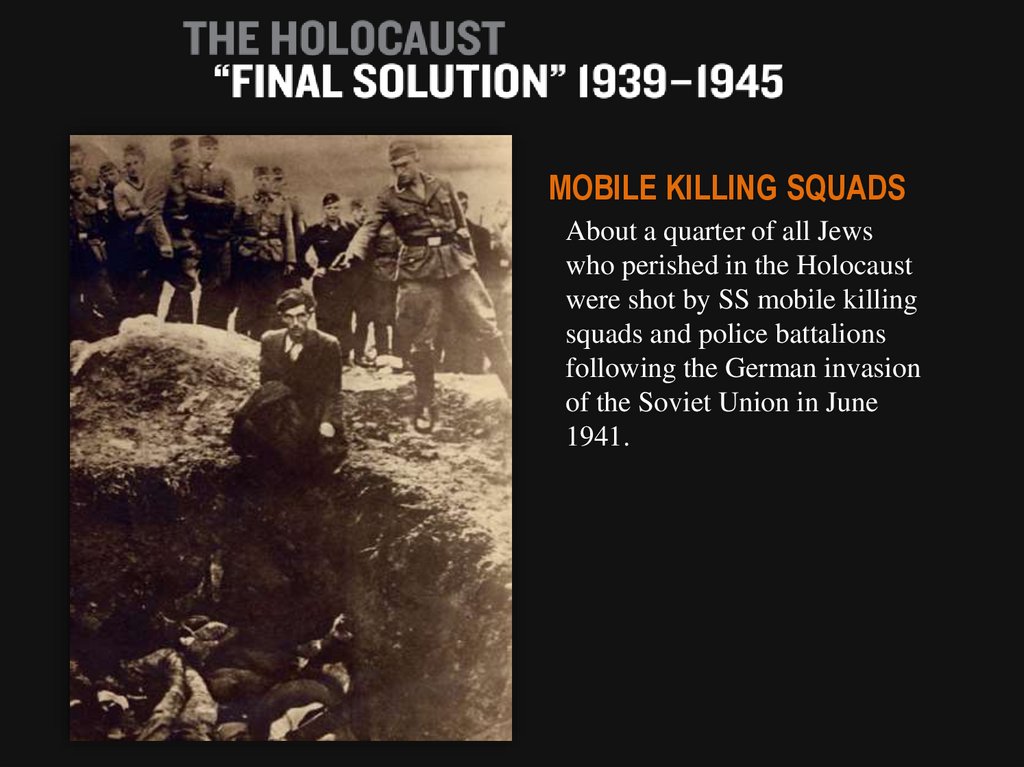






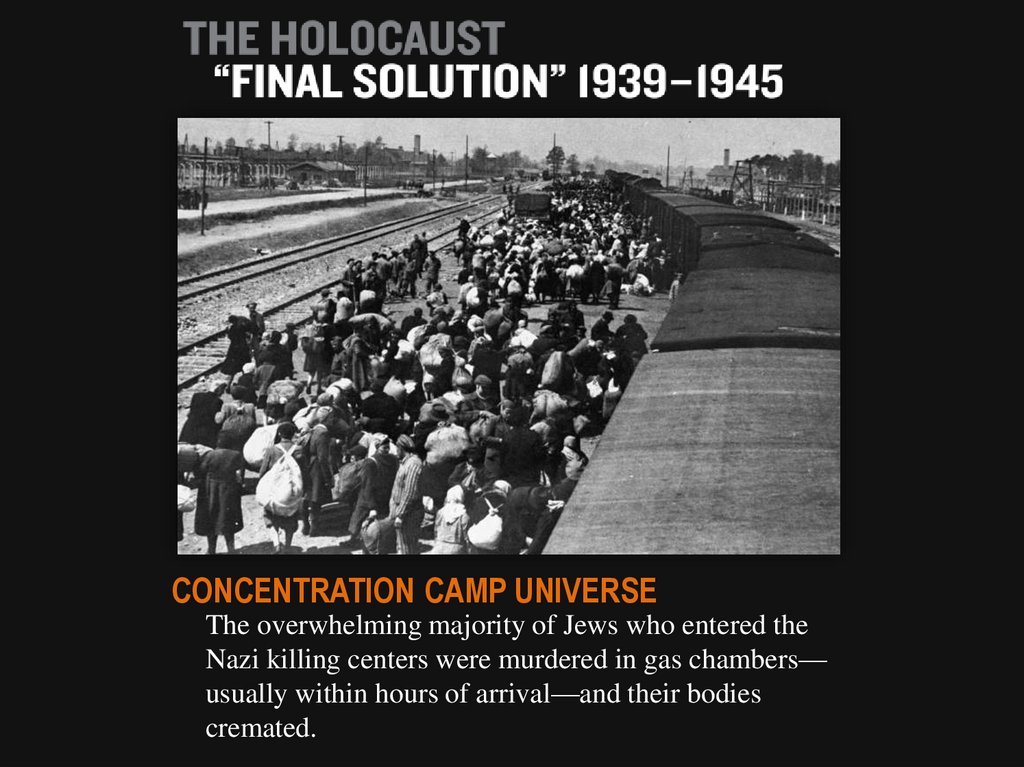

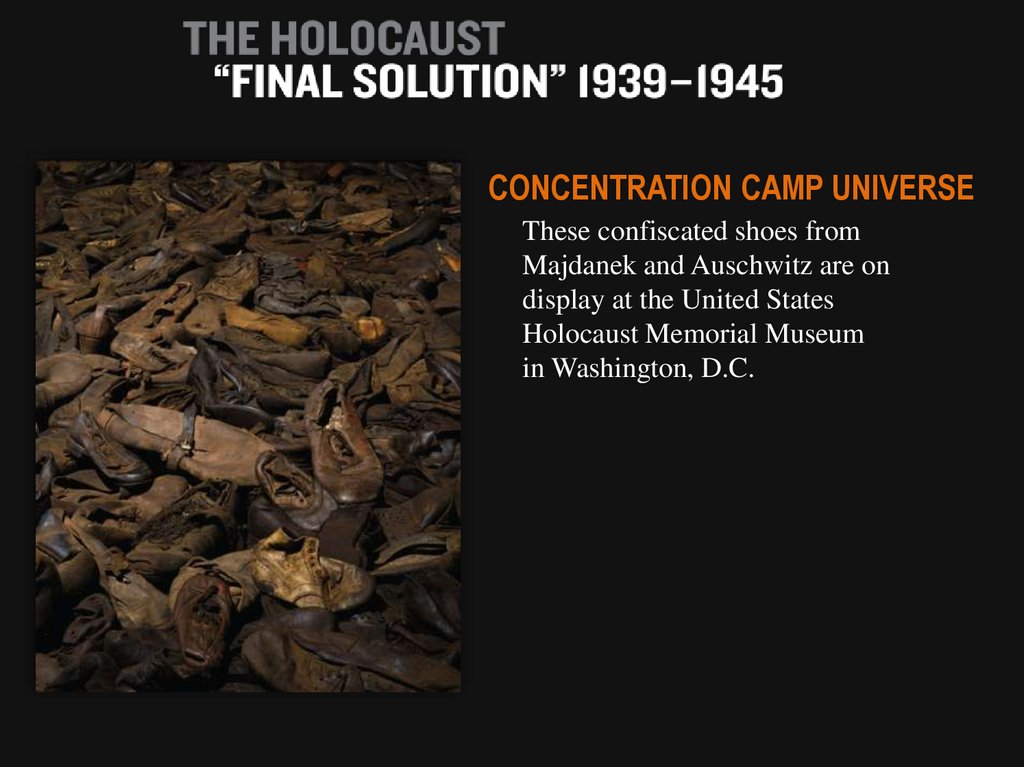
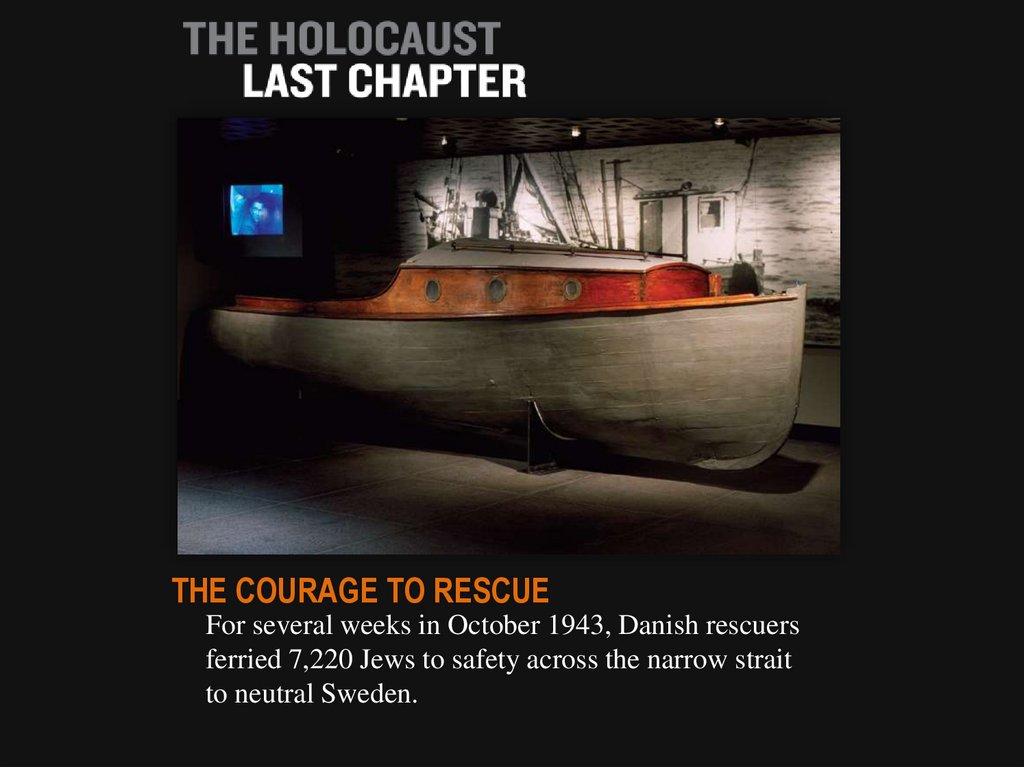






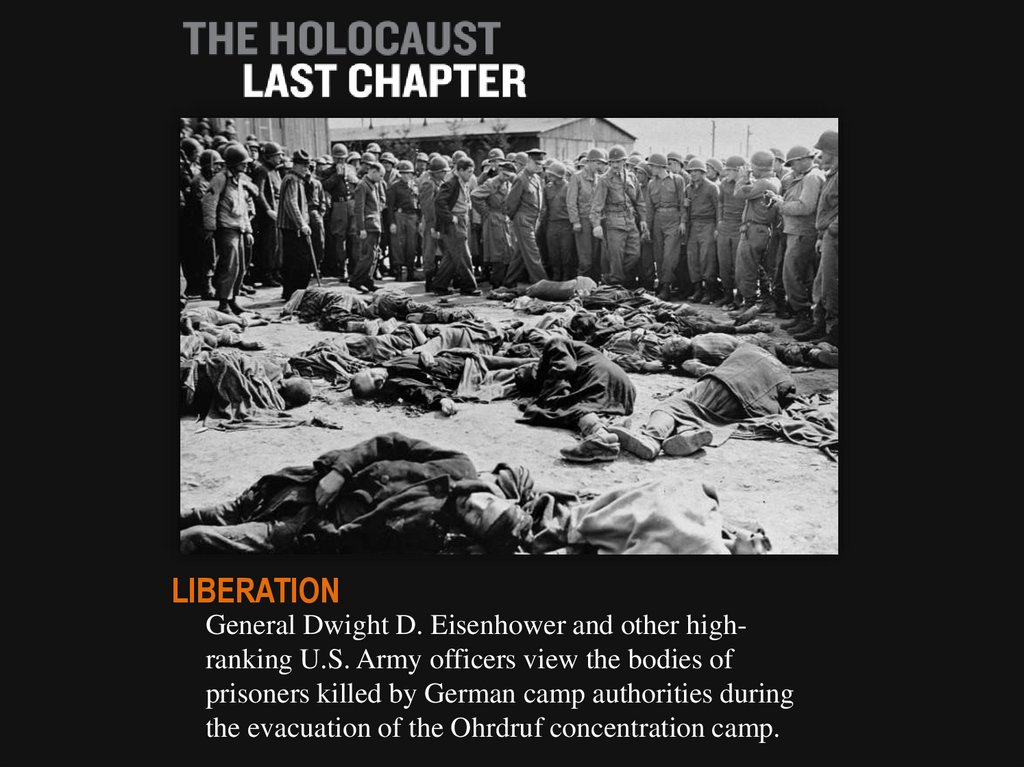





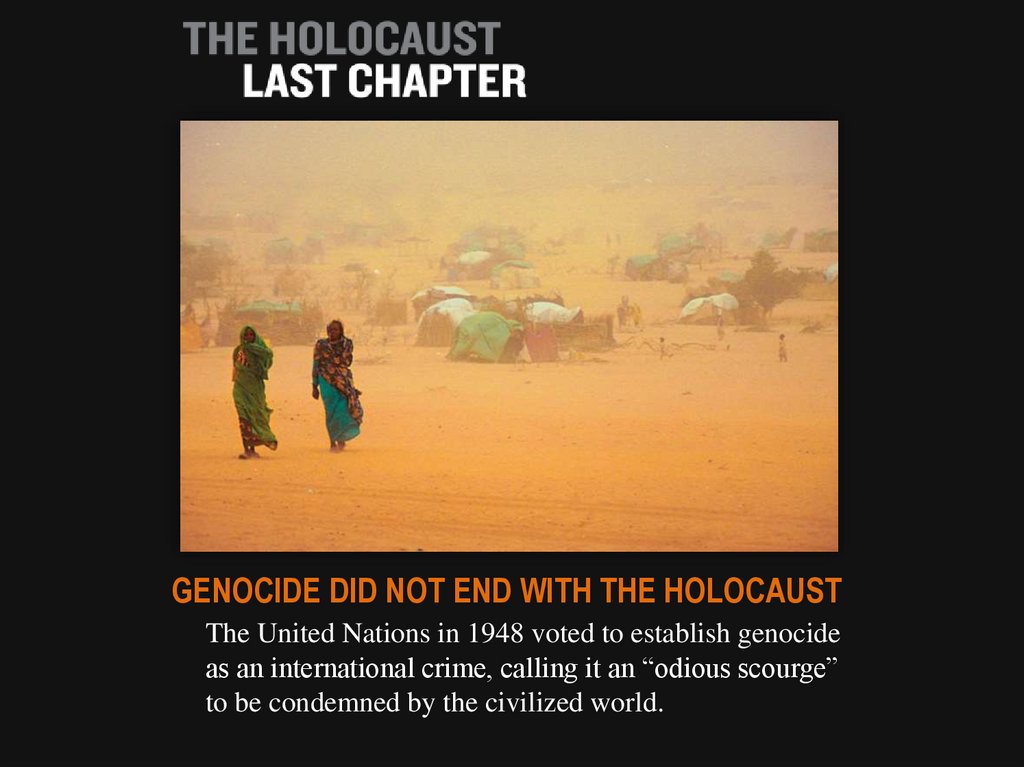


 История
История








